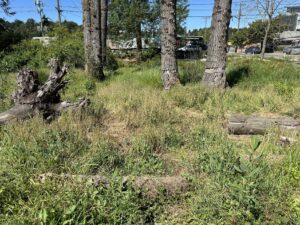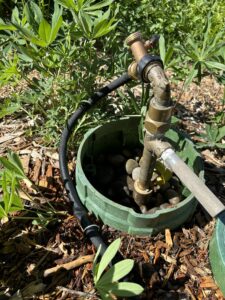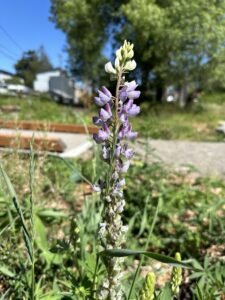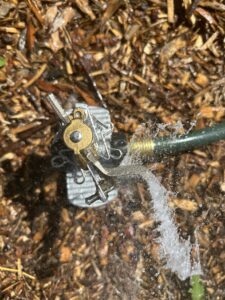A Wetland Isn’t Always Wet: Summer Irrigation at Delridge Wetland Park
Along with hosting community events and our annual Summer Youth Program, Delridge Neighborhoods Development Association (DNDA) is also spending this summer watering native plants at Delridge Wetland Park.
Most plants at the wetland are less than a year old, and without developed root systems they likely would survive the summer without being irrigated. That’s where DNDA’s Nature Team comes in!
Although the term “wetland” implies that water will always be present in these areas, many wetlands in the Pacific Northwest are not wet year-round. The wide range of altitude, hydrologic conditions, and seasonal precipitation throughout Washington makes these ecosystems, called “seasonal wetlands,” common. DNDA’s Delridge Wetland Park is one of them.

The central wetland area at Delridge Wetland Park in June 2024. The area is dry and grassy, a common sight at seasonal wetlands in the Pacific Northwest.
When it rains, Delridge Wetland Park receives water from stormwater pipes under 21st Ave SW, which collect runoff from the surrounding neighborhood. This water sinks back into the ground or travels slowly through a series of bioswales, and if the level is high enough, it leaves the wetland through a pipe to Longfellow Creek. The wetland is consistently filled with water, or “ponded,” throughout Seattle’s wet season, but the water evaporates or replenishes the groundwater and disappears as the dry season begins.

We connect the soaker hose to a quick coupler to irrigate parts of the wetland, which plugs into the irrigation valve.
DNDA’s irrigation method involves a combination of sprinklers and soaker hoses. Sprinklers rotate and spray over a far distance, allowing the water to reach a large area of the wetland. At the same time, soaker hoses trail along the ground and are a more efficient method for smaller, irregularly shaped areas with widely spaced plants. To ensure the soil gets saturated and the water does not evaporate before the roots can take it in, we water the young plants two days in a row, every other week.
Urban forestry restoration practices often include irrigating young plants to help them establish. Planting native species will almost always reduce the need for supplemental watering. Still, for projects like Delridge Wetland Park, sometimes irrigation is necessary during the early stages of restoration to ensure native plants’ long-term health.

Lupine, a wildflower native to the Pacific Northwest, blooms with lavender and yellow flowers. Lupine is an important species for native pollinators.
This is more likely for projects like the wetland, which underwent a significant hydrological change as part of their restoration. While the park was under construction, Seattle-based contractor Iliad installed an underground irrigation system that allows DNDA to water the wetland’s young, vulnerable plants during the summer months.
Delridge Wetland Park is one of many parks DNDA has needed to irrigate during the dry season. At one of our other restoration sites, Pigeon Point Park, we watered a field of young trees and shrubs for about four years. Today, the native plants are successfully reestablishing and continue to thrive during the summer. Similarly to Pigeon Point, Delridge Wetland Park will require watering over the next few summers.
We are thrilled with the progress of the wetland’s youngest plants so far and are excited to watch the park continue to grow and provide an essential habitat for many native species. If you want to join us in restoring Delridge Wetland Park or any DNDA’s other sites, you can sign up at dnda.org/nature.
If you’re interested in learning more about how projects like the wetland impact the health of Longfellow Creek, consider joining our new Longfellow Creek Stewardship Program! DNDA and Duwamish Alive! Coalition are starting this community-based initiative that will provide the opportunity for Delridge residents to do hands-on water quality monitoring in Longfellow Creek. Through the program, community members can learn more about their local watershed, contribute to exciting citizen science projects, and connect with community members. To learn more or sign up, visit dnda.org/lfcstewards.
- Written by Environmental Engagement Specialist Louisa Keyani

